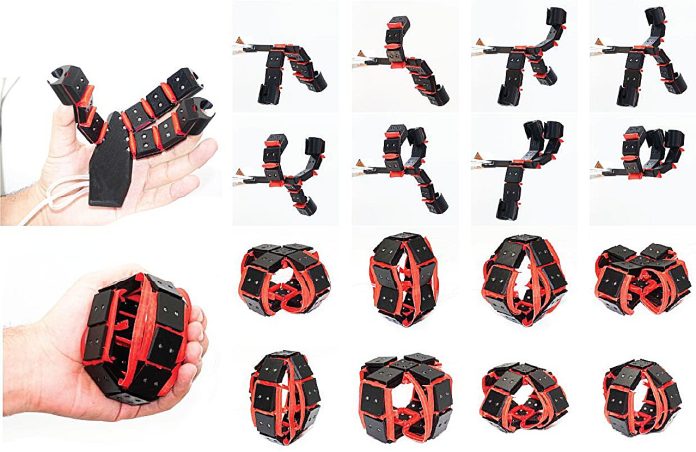
Scientists at EPFL in Switzerland have developed a new soft robotic system that could change how we feel and interact with digital environments.
This system, called Digits, is made up of small, customizable robot modules that use compressed air to bend, vibrate, or change shape, creating a realistic sense of touch.
These features could be especially useful in virtual reality, physical therapy, and rehabilitation.
Even though the Digits system can take on 16 different shapes, the building blocks behind it are surprisingly simple. Each module, or “Digit,” is made of solid links connected by flexible joints.
These joints contain small air pouches that inflate or deflate to move or stiffen the module.
This allows the robot to mimic many types of human touch, from light vibrations to firm pressure.
In a recent study, the research team showed off two working designs made from the Digits system.
One is a wearable glove called TangiGlove, and the other is a handheld ball called TangiBall. The glove acts like a soft robotic exoskeleton, gently pushing or resisting the user’s hand movements to create realistic touch sensations.
The ball can change between shapes like a cube or sphere and provides feedback through both shape and vibration.
Most haptic (touch-based) technologies only focus on one kind of sensation, like vibration or stiffness.
That’s because touch is a complex sense—unlike seeing or hearing, we need to interact with objects to feel their texture, shape, or weight. Creating technology that can match that complexity is a big challenge.
What makes Digits special is its ability to combine different touch sensations while remaining flexible, simple to use, and easy to adjust for different purposes.
Another innovation is how Digits is controlled. The researchers used compressed air, a method that’s not often used in haptic devices but is lightweight, quiet, and highly adjustable. They also improved the open-source software called Feelix to work with their system.
With this upgrade, people can design custom touch feedback patterns using a machine-learning interface—no programming skills needed.
Digits could make virtual and augmented reality experiences more lifelike by allowing users to “feel” virtual objects. It could also be used in rehab settings, helping patients regain strength and movement through gentle and interactive exercises. Because the system can adjust quickly to different shapes and stiffness levels, it’s ideal for real-time use in changing environments.
The team plans to explore new uses for Digits, including long-term therapy tools and more advanced virtual reality systems. Their goal is to make human–machine interaction more natural and inclusive, using soft robots that can adapt to people of all sizes and needs.
Source: EPFL.



